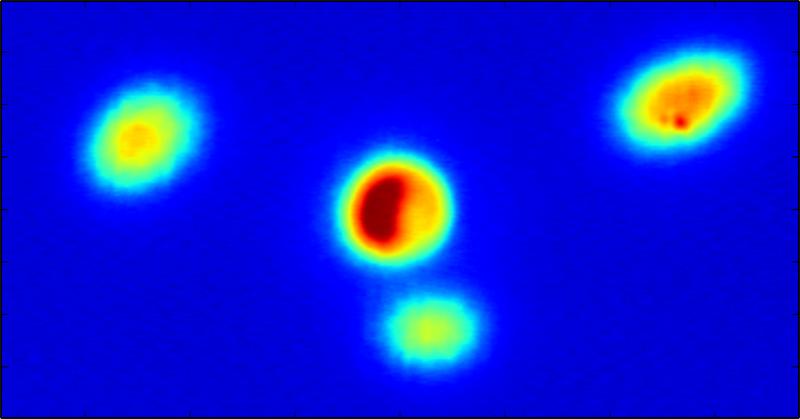
Successful Twin Orbit Testing at BESSY II: New Beam Dynamics

A synchrotron source point image of a bending magnet of the Twin Orbit modus. The second orbit closes after three revolution and is winding around the standard orbit at the center. Credit: HZB
The Twin Orbit operation mode makes use of non-linear beam dynamics and provides two stable well separated orbits for storing two electron beams in one storage ring. The bunch fill patterns of both orbits can be chosen, to some extent, independently, which allows for fulfilling normally incompatible user needs, simultaneously.
For example, one orbit can be used to store a homogenous multi bunch fill to deliver high average brilliance for photon hungry experiments, whereas only one single bunch is stored on the other orbit for timing experiments, providing a much lower pulse repetition rate.
First experiments in 2015
It is a long process from an idea to a real operational week, especially at a running multi user facility. First studies of this mode started already 2015 at the smaller ring, the Metrology Light Source (MLS), resulting in a successful user experiment with the Physikalisch Technische Bundesanstalt (PTB) [1]. In parallel a group of HZB experts implemented and optimized this mode at BESSY II in single machine commissioning shifts.
Important milestones have been the operation of a large number of insertion devices as well as the topping up injection scheme to keep the stored current constant. In 2017 a successful overnight run with topping up injection and some participating beamlines gave confidence for a first longer test week [2].
Excellent availabilty of synchrotron light
The days of this “Twin Orbit User Test week” have been used for common experiments of machine group and beamline scientists in order to characterize this operational mode and generate feedback for further optimization. During the nights and the complete weekend ‘normal’ user time was scheduled with two different fill patterns (multibunch and single bunch) on both orbits. The availability and stability of the synchrotron source were comparable to the current standard user mode and exceeds/reaches 99 per cent.
Elegant option for BESSY VSR
“There is still a lot of work to do, but nevertheless this proof-of-principle week showed that a development towards a realistic user mode should be possible. And even more, for the future BESSY VSR project, it could be a very elegant way to separate short and long bunches”, Prof. Andreas Jankowiak concludes.
[1] http://accelconf.web.cern.ch/AccelConf/IPAC2015/papers/mopwa021.pdf
[2] http://accelconf.web.cern.ch/AccelConf/ipac2017/papers/wepik057.pdf
More Information on Twin Orbit Modus:
Dr. Paul Goslawski















